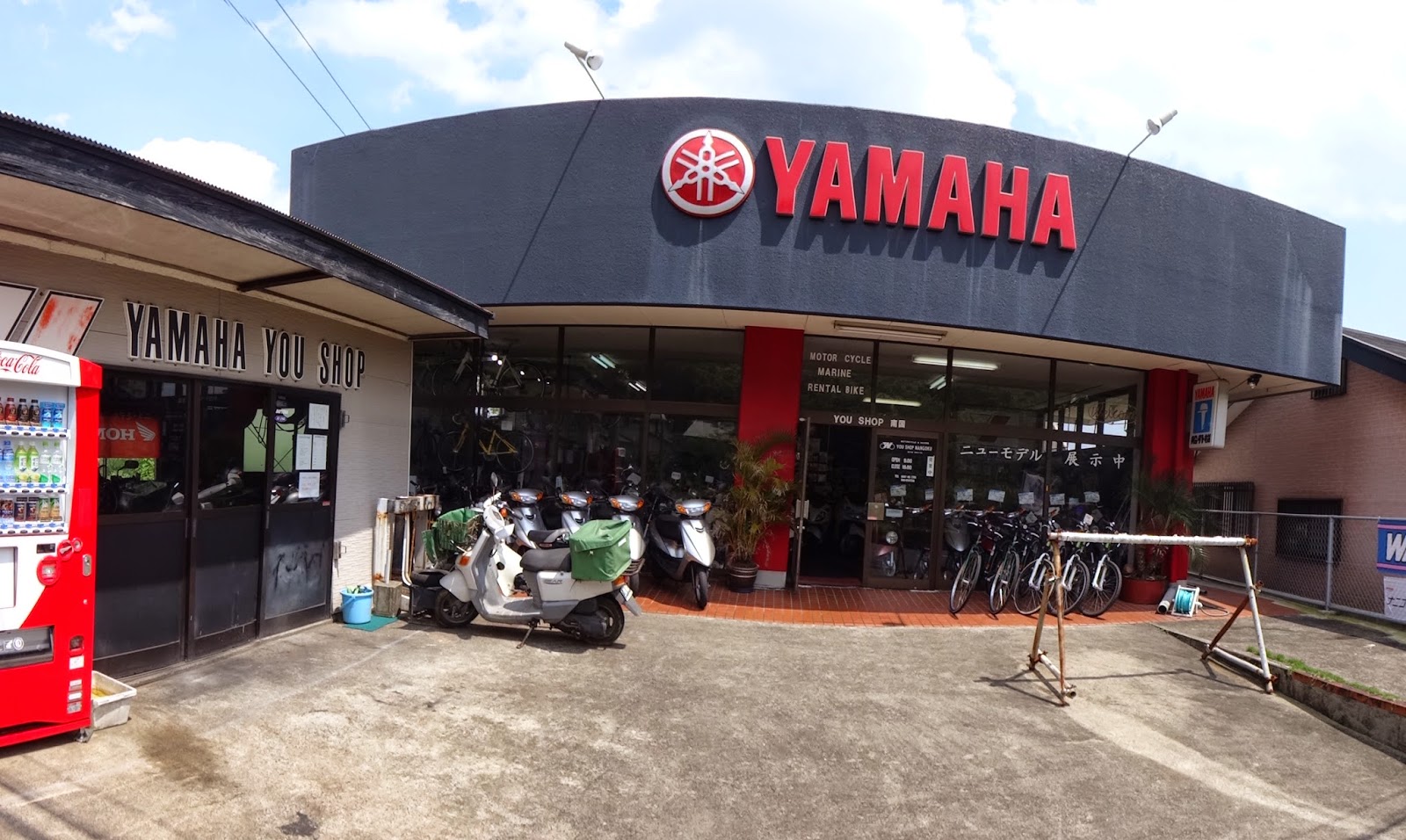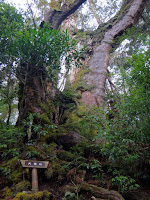Just like hiking, there are many options for cyclists visiting
Yakushima. There are several places you can rent bicycles round the
island and if you do a little homework, you'll surely find a ride that fits your style.
Cycling Activities:
From simple transportation between your accommodation and the store, to watching the sunset and the see turtles lay their eggs after the buses have stopped running, to blissful rides through the forest, bicycling is a popular (although exhausting with all these hills!) means of getting around, but for those seeking more, here are a few suggestions:
 The West Forest Road (Seiburindou)
The West Forest Road (Seiburindou)
On
the West side of Yakushima, the road narrows and winds right through
the World Natural Heritage Site. (Yes, Yakushima is one of the few
places you can drive or cycle through a World Natural Heritage Site.)
Cars and tour buses can also use the road, but traffic is less than in
other parts of the island and drivers are careful because the road is
very windy and this area is particularly famous for deer and monkeys.
Large troops forage, frolic, and relax along the road and in the
surrounding forests. The road climbs up to an elevation of about 300m,
but even if you have to get off your bike and walk part way, most people
agree: It's worth it. In fact, you'll want to jump off your bike
regularly to watch the animals. But please, do not feed them, antagonize
or intimidate them, and don't leave your lunch unattended! (And avoid eye contact with the monkeys.) No matter how docile they may appear, they are wild animals, so please watch for defensive/aggressive behavior and back off if you need to.

I
suggest packing a bento lunch, rain gear or sunscreen, water, and a portable-toilet pack,
then taking a bus
to Nagata where you can pick up a rental cycle. (You'll want to place a
reservation to make sure one is available.) UFORTUNATELY RENTAL SERVICES NEARBY HAVE BEEN CUT IN 2016.Shortly after departing Nagata, stop at the
lighthouse, and then continue climbing up the hilly road at a leisurely pace,
stopping wherever you like. Eventually, you'll hit the road's highest
elevation and begin a long descent. Be careful not to let your bicycle
get away from you; pump the breaks gently to keep them from overheating
and failing. After you cross the Segire River and leave the World
Natural Heritage Site, you'll come to Oko Waterfall, where you can use
the rest room as well as relax in the cool mist of the powerful falls that
gained Oko status as one of Japan's Top-100 Waterfalls. You can return
your bicycle at the shop in Kurio, or continue on.
 Bicycle Tours*
Cameron, the friendly hiking guide over at Yakushima Experience
Bicycle Tours*
Cameron, the friendly hiking guide over at Yakushima Experience offers bicycle tours. He'll pick you up
with rental cycles and take you on a tour of the western side of the
island (including the West Forest Road) ranging anywhere from 25 to 50
kilometers and from three to seven hours depending on your tastes,
although he emphasizes a leisurely pace with plenty of photo
opportunities and wildlife viewing. Staff will meet you on the other
side to take you back with the option of stopping by a hot spring.
Prices range from 12500 yen per person for groups of four or more to
17000 for solo riders.
 Annual Cycling Event*
Annual Cycling Event*
Enjoy
aid stations, police support, photo opportunities, point-of-interest
stops and
more as local volunteers cheer for you and hundreds of other cyclists
making their way around the 100km parameter of the island. Half (50km)
and family (20km) course lengths are
also offered, but this is not a timed raced. Rental cycles may be booked
out, so reserve your space as well as a bicycle (and a helmet!) or
bring your own. In 2015 participation fees ranged from 3,000 yen for the
short course to 9,500 yen for the full course, and applications were
due the month before the event. The
Cycling Yakushima event is held annually in February, so check the calendar!
Challenge Routes
The
main road that wraps around Yakushima is just over 100km around and
climbs up to an elevation of about 300m. If you're looking for a crazy (as in, maybe you want to see hour far you can go until you drop dead) challenge you can cycle up to the trail head at Shiratani Unsuikyo Park
(650m el.) or Yodogawa (1365m el.). Please note that cyclists and
pedestrians are not allowed on the turnoff leading to the Arakawa Trail
Head for Jomon Sugi from March through November.
Renting a Bicycle*
- You Shop: If you are a serious cyclist, you'll enjoy a trip to the YOU Shop in Anbo. The owner welcomes foreigners, and you can rent anything from 21-speed cross-bikes and mountain-bikes from 800 yen/day to road bikes for 3,000 yen/day. They have both overnight and hourly rates, and if you bring your own pedals, they'll even install them for you.

| 
| 
|
| The You Shop offers both mid-range cycles (middle) and high-end cycles (right). |
The You Shop is open daily from 9am to 6pm and rents helmets and rain gear to customers who are renting bikes.

- Midori no Kaze (formerly Mori) Rental Cycles are basic multi-speed bicycles that can be picked up and dropped off at different locations around the island for 800~1050 yen per day depending on the quality of the bike. Pickup/dropoff points open between 6:30 & 9:00am and close between 5:00 & 7:00pm. If you keep a bicycle past closing time, you will be charged for two days.
In clockwise order beginning in Nagata, cycles can be picked up and dropped off in the towns of
Nagata, at the Marusou Gasoline Stand,
Issou, at the Higo Gasoline Stand (closed on Sundays),
- Miyanoura, at Uchida Gasoline Stand
or the Yakushima Kankou Center (30.430,130.5689, NOT the Tourist Information Booth. The Kankou Center also offers cross bikes which must be returned to the same location),
Koseda, at the Nanpou Gasoline Stand,
- Anbo, at the Midori no Kirameki (Mori no Hidamari) Gift Shop,
Mugio, at the Botanical Research Park,
Onoaida, at the Hidaka Gasoline Stand (Closed on Sundays),and
Kurio, at the S-Mart convenience store,
UNFORUTNATELY, MOST RENTAL LOCATIONS HAVE BEEN CUT AS OF SUMMER 2016. as well as at a few other locations. Check for the latest locations and call first or make a reservation to make sure that a bicycle will be available for you, especially if you plan to pick one up from a smaller location. Please note that insurance is not included with these bicycles, and you are liable for up to 15000 in damages. These bicycles are meant to handle loads up to 85 kg. If you don't have your rental receipt when you return the bicycle you will be charged an extra 500 yen.

- Yakushima Kankou Center: As an extension of the Midori no Kaze bicycle rentals, the Yakushima Kankou Center in Miyanoura also a high-quality tear (green bicycles in the righthand photo) for 1500 yen/day, but they must be returned to the Yakushima Kankou Center.
- Accomodations with bicycles: Quite a few accommodations offer free or charged rental cycles of varying quality. For example, the Portside Youth Hostel in Miyanoura allows guests use of a bicycle for up to a half hour, and Tashiro Annex (also in Miyanoura) and Iwasaki Hotel (Onoaida) even have motor-assist bicycles available for rent.
Some accommodations are even part of the Midori no Kaze system.
Bringing your own bicycle
Shipping your
bicycle from Tokyo to Kagoshima costs around 30000 yen, and you can't do
it (as far as I know) from the airport. However, I have seen folks assembling bicycles
outside the airport in Yakushima. You cyclists never cease to amaze me!
If you're doing a bicycle tour of Japan, then come by ferry (
Yakushima Ferry 2),
and you can bring your bicycle aboard for an extra 900 yen each way at
time of writing. (You'll need to be at the port in Kagoshima before 7am,
and during Japanese holidays, you'll need a reservation. Every so
often, the ferry is also docked for routine inspection, so you'll want
to check before you make your plans.) You can also take your bicycle if
you are stopping by the flatter neighboring island of Tanegashima, in which case
you can use the
Ferry Hibiscus.
Hazards
Wherever you go, you may have to contend with rain, and
even though the speed limit is between 30 and 50 kph almost everywhere,
the roads are narrow and often do not have a shoulder. You'll have to
contend with rental cars and skilled-but-brazen bus drivers along with the regular
traffic. And, of course Yakushima is hilly. Please check the breaks when
choosing a rental cycle (Front and rear breaks may be backwards of what
you are used to.) and remember to use front and rear lights at night.
*Hours, prices, and locations are subject to change, so please check with respective businesses when you make your plans.









































